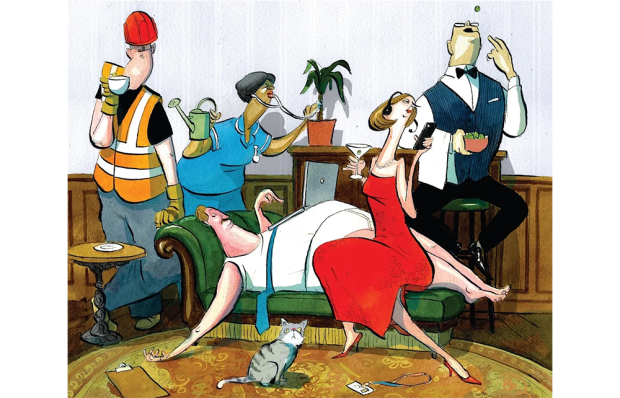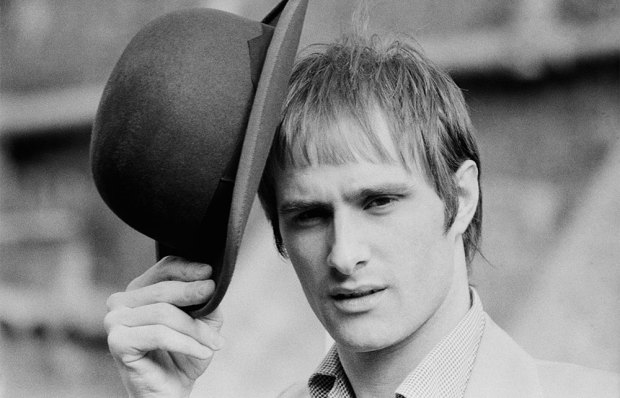We self-critical British should never forget that other nations are pretty crazy too. I write this from Andalusia, Spain; and when it comes to cockeyed rules for limiting the spread of Covid-19, the Spanish offer us some stiff competition. One is reminded of the Mad Hatter’s Tea Party. Very gradually (I’d guess) over the months during which Spaniards have been subject to a face-mask regime, people seem to have lost touch with the reasons the rules were laid down in the first place. Practices have simply been absorbed into popular culture, their origins now ignored, forgotten or never understood.
We landed in Almeria from Manchester last week and, wearing our face masks like other Ryanair passengers, picked up our hire car and headed out on to the motorway for the hour-long drive to our destination town, passing through empty semi-desert and seeing nobody until we got there. Night fell as we drove in. Entering the brightly lit town felt like coming from outer space into a new planet, its streets, restaurants and bars busy, peopled by creatures very like us, yet strangely different. We peered out of our car windows, trying to take it in.
They were wearing masks in the open air and taking them off to go into enclosed spaces! Not everybody was obeying what appeared to be common practice, but most were. Thus began our study, which continues as I write this seated outside a bar in a small village not far from the Mediterranean.
The first rule is that almost everyone carries a face mask at all times. Most use the simple white or pale blue fabric mask with a wire through the top edge to help grip the bridge of the nose. Next, then, to the circumstances in which they put it on.
It seems that if you are serving or assisting in a bar, restaurant or shop, you keep your mask on at all times, indoors and out. So far, so rational. But customers’ habits are different. Broadly, these appear to encourage the wearing of masks for walking or transacting business, but not in social or convivial circumstances. So you wear a mask, for example, if strolling down the road accompanied or unaccompanied: even on an almost empty pavement, or by the highway, or down the footpath to the beach.
You arrive at (say) the bar of your choice in your mask. You then sit down at a table outside or within, or at the bar stool itself — and take off your mask! Likewise at the beach: arrive in mask, sit down on the sand among other beach-goers, spread out your towel, remove your mask. I hardly saw anyone wearing a mask unless they were standing up. In one village in the Alpujarras on the verdant slopes of the Sierra Nevada mountains, I emerged from a bar — busy, noisy, hot, and crowded with the usual old men drinking and talking and shouting at the football referee on the television, not one of them masked — and into a quiet street, down which a couple of villagers were walking, masked-up in the open air. We were lunching at the tables outside, watching as masked customers arrived in ones and twos, sat down close to other diners, and removed their masks.
What seems to have happened (and it’s only a guess) is that the mask has become an accessory, signalling the virtues of social responsibility, but actually worn only when convenient. Bars there must be. Restaurants there must be. Laughter, backslapping and unmuffled conversation there must be. Beverages must be sipped; food must be munched; and politely kiss we must. These things being impossible through a muzzle, the mask is simply dispensed with.
Dispensed with, yes, but kept by you and visible at all times. Kept where? Certain patterns seem to be emerging. The cool youths often wear them like an armband above the elbow. Since removing the mask for use then means pulling your arm out of both elastic loops, this seems to say ‘I could, but am not expecting to’.
The bustling lady running our restaurant yesterday wore hers hanging by one elastic loop from her right ear. This seemed to say ‘mostly this stays on but, Lord, I need a breather’. Others simply slip mask under chin like a little bib, and this is common but (I sense) thought a little inelegant. One or two slip them upwards and on to their foreheads, as some slickers do with sunglasses: but stored here the mask has a habit of slipping back down over the eyes.
Last night, however, we just may have seen the future. A chap in a neat suit had folded his mask into a neat point and tucked it into the breast pocket of his jacket, only the point showing, as a gentleman might do with the handkerchief into which he is never going to blow his nose.
It’s about display, isn’t it? Apparently during the Renaissance there arose a fashion for men’s garments to sport a pre-sewn slit, to hint at a (highly unlikely) recent sword fight. Ripped jeans in our day, or lads with trousers half down, are a nod to the 21st-century fashionability of victim status. It all puts me in mind of something Chris Patten remarked when I mentioned the widespread use in church of ghastly sound-amplification systems, which priests first tap to check they’re working. In a hundred years, said Chris, the priest will begin Mass by tapping three times on an object that you and I would recognise as a replica 20th-century microphone, but the faithful of the future see only as a mysterious symbol, anciently associated with holy ritual.
One day, perhaps, after this pandemic and pandemics still to come are part of a half-forgotten history, ladies will still hang elegant fabric pendants from one ear, young dudes will sport a piece of muslin above the elbow, and the well-dressed gentlemen will allow just a discreet tip of pale blue to emerge from his breast pocket. And nobody will remember why.
Got something to add? Join the discussion and comment below.
Get 10 issues for just $10
Subscribe to The Spectator Australia today for the next 10 magazine issues, plus full online access, for just $10.
You might disagree with half of it, but you’ll enjoy reading all of it. Try your first month for free, then just $2 a week for the remainder of your first year.















Comments
Don't miss out
Join the conversation with other Spectator Australia readers. Subscribe to leave a comment.
SUBSCRIBEAlready a subscriber? Log in